ACCT6001 Business Process Re-engineering: GAAM Company Analysis
VerifiedAdded on 2023/06/10
|5
|848
|117
Case Study
AI Summary
This assignment focuses on the business process re-engineering of GAAM Company, an international manufacturer facing procurement process weaknesses. It identifies the need for redesigning core business processes to achieve efficiency and effectiveness. The solution proposes formulating clear procurement goals, utilizing procurement information systems, redesigning purchasing needs determination, and incorporating tendering and internet buying. It also emphasizes the adoption of information technology solutions such as databases, Enterprise Resource Planning (ERP) systems, e-procurement, Radio Frequency Identification (RFID), and cloud-based platforms to address inefficiencies. These technologies aim to improve workflow, reduce costs, enhance compliance, and streamline procurement processes, ultimately leading to better value delivery to customers.
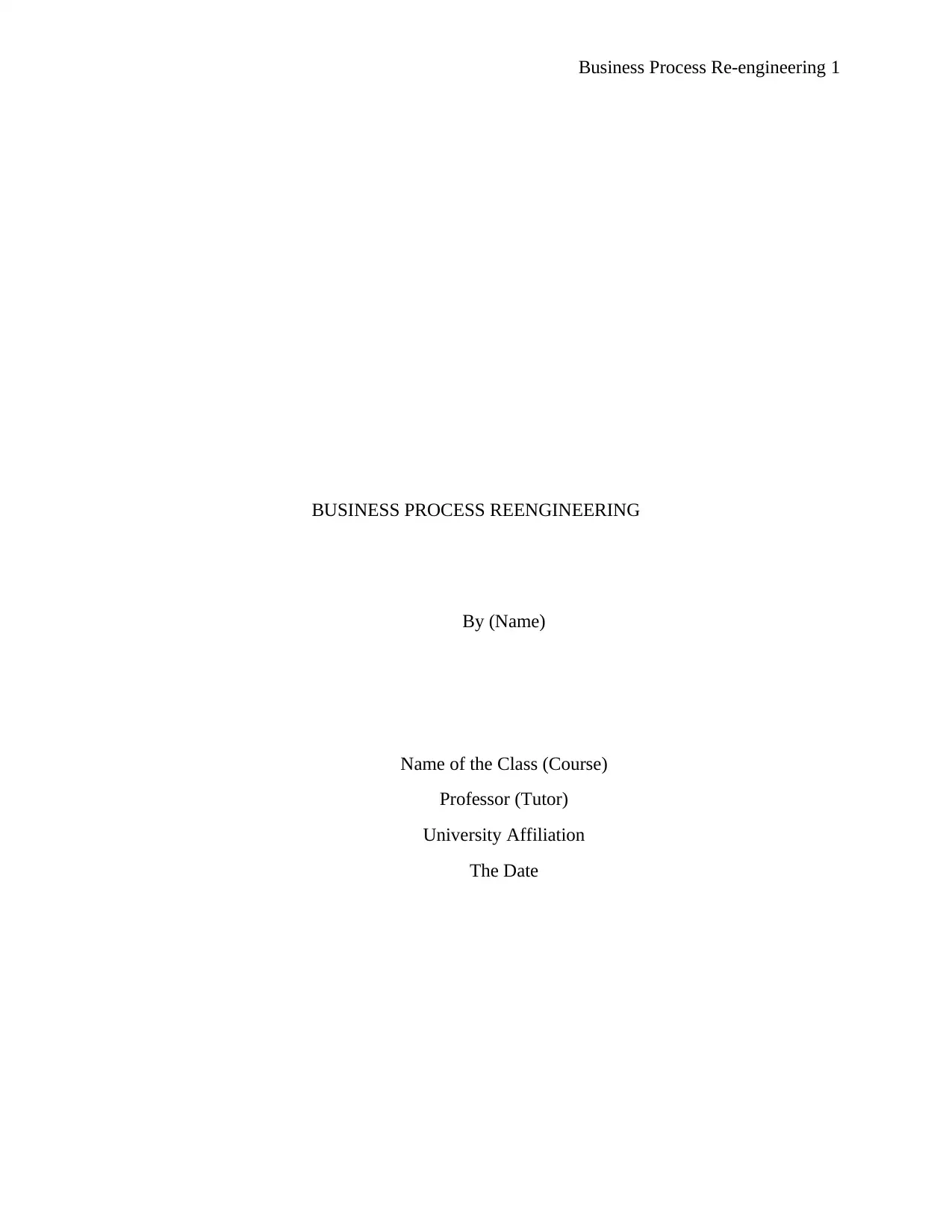
Business Process Re-engineering 1
BUSINESS PROCESS REENGINEERING
By (Name)
Name of the Class (Course)
Professor (Tutor)
University Affiliation
The Date
BUSINESS PROCESS REENGINEERING
By (Name)
Name of the Class (Course)
Professor (Tutor)
University Affiliation
The Date
Paraphrase This Document
Need a fresh take? Get an instant paraphrase of this document with our AI Paraphraser
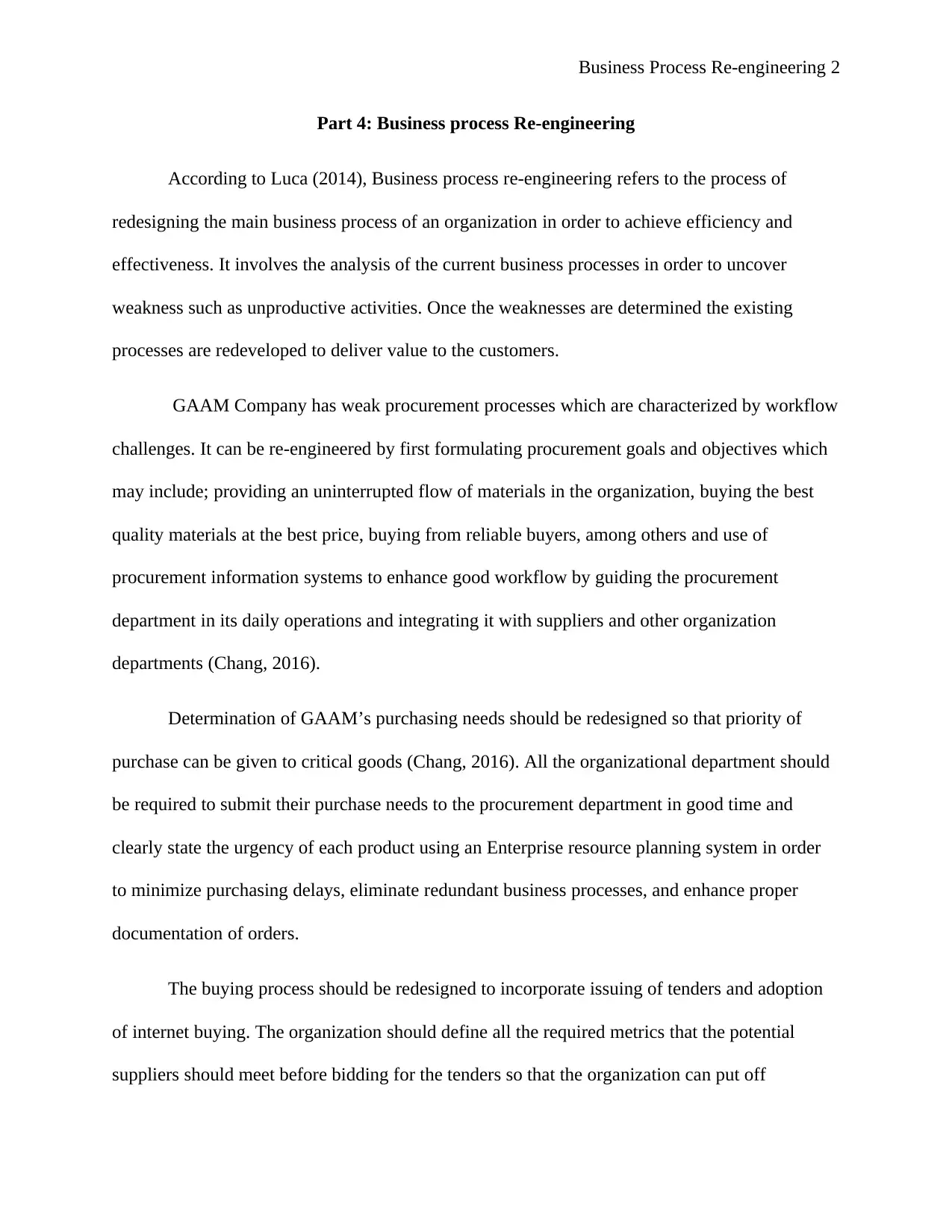
Business Process Re-engineering 2
Part 4: Business process Re-engineering
According to Luca (2014), Business process re-engineering refers to the process of
redesigning the main business process of an organization in order to achieve efficiency and
effectiveness. It involves the analysis of the current business processes in order to uncover
weakness such as unproductive activities. Once the weaknesses are determined the existing
processes are redeveloped to deliver value to the customers.
GAAM Company has weak procurement processes which are characterized by workflow
challenges. It can be re-engineered by first formulating procurement goals and objectives which
may include; providing an uninterrupted flow of materials in the organization, buying the best
quality materials at the best price, buying from reliable buyers, among others and use of
procurement information systems to enhance good workflow by guiding the procurement
department in its daily operations and integrating it with suppliers and other organization
departments (Chang, 2016).
Determination of GAAM’s purchasing needs should be redesigned so that priority of
purchase can be given to critical goods (Chang, 2016). All the organizational department should
be required to submit their purchase needs to the procurement department in good time and
clearly state the urgency of each product using an Enterprise resource planning system in order
to minimize purchasing delays, eliminate redundant business processes, and enhance proper
documentation of orders.
The buying process should be redesigned to incorporate issuing of tenders and adoption
of internet buying. The organization should define all the required metrics that the potential
suppliers should meet before bidding for the tenders so that the organization can put off
Part 4: Business process Re-engineering
According to Luca (2014), Business process re-engineering refers to the process of
redesigning the main business process of an organization in order to achieve efficiency and
effectiveness. It involves the analysis of the current business processes in order to uncover
weakness such as unproductive activities. Once the weaknesses are determined the existing
processes are redeveloped to deliver value to the customers.
GAAM Company has weak procurement processes which are characterized by workflow
challenges. It can be re-engineered by first formulating procurement goals and objectives which
may include; providing an uninterrupted flow of materials in the organization, buying the best
quality materials at the best price, buying from reliable buyers, among others and use of
procurement information systems to enhance good workflow by guiding the procurement
department in its daily operations and integrating it with suppliers and other organization
departments (Chang, 2016).
Determination of GAAM’s purchasing needs should be redesigned so that priority of
purchase can be given to critical goods (Chang, 2016). All the organizational department should
be required to submit their purchase needs to the procurement department in good time and
clearly state the urgency of each product using an Enterprise resource planning system in order
to minimize purchasing delays, eliminate redundant business processes, and enhance proper
documentation of orders.
The buying process should be redesigned to incorporate issuing of tenders and adoption
of internet buying. The organization should define all the required metrics that the potential
suppliers should meet before bidding for the tenders so that the organization can put off
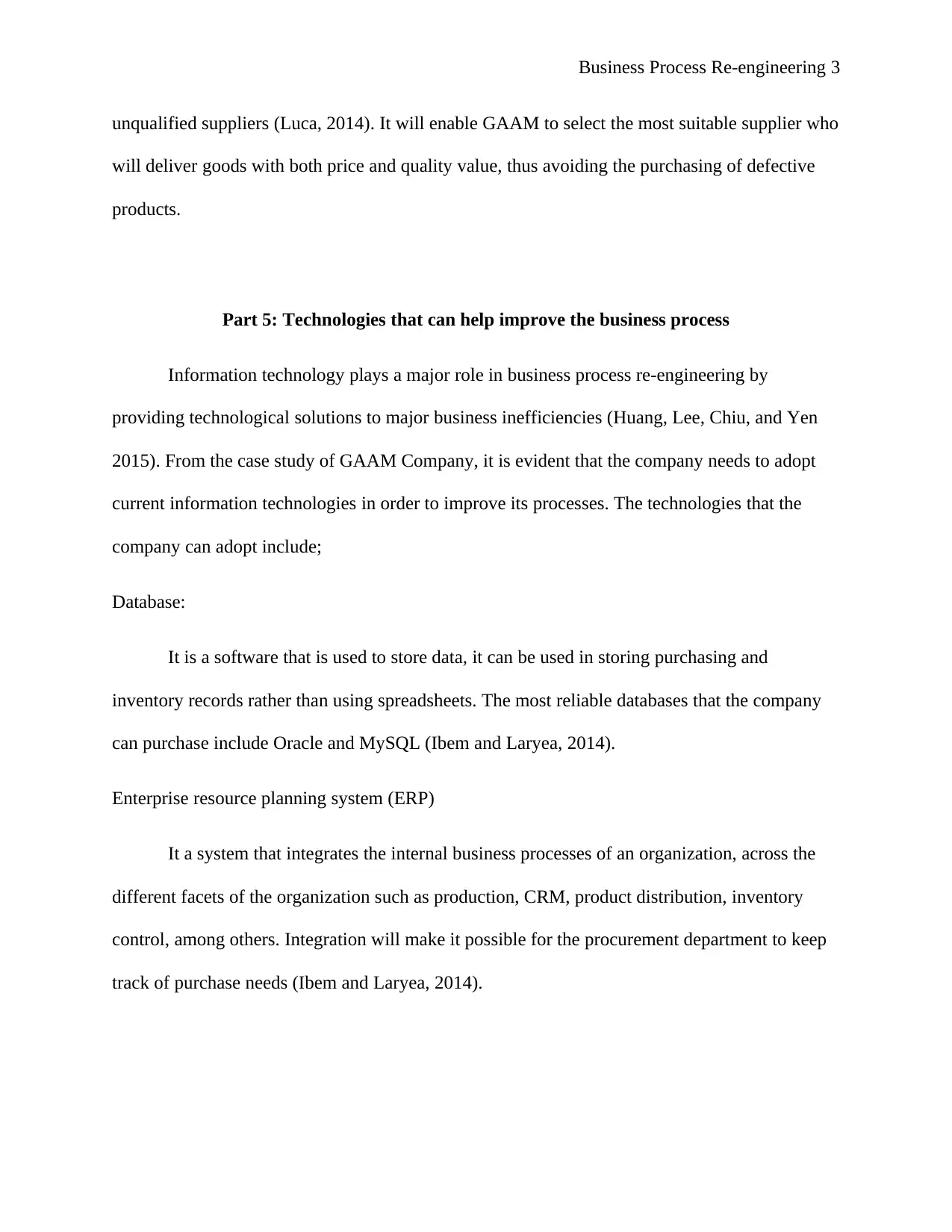
Business Process Re-engineering 3
unqualified suppliers (Luca, 2014). It will enable GAAM to select the most suitable supplier who
will deliver goods with both price and quality value, thus avoiding the purchasing of defective
products.
Part 5: Technologies that can help improve the business process
Information technology plays a major role in business process re-engineering by
providing technological solutions to major business inefficiencies (Huang, Lee, Chiu, and Yen
2015). From the case study of GAAM Company, it is evident that the company needs to adopt
current information technologies in order to improve its processes. The technologies that the
company can adopt include;
Database:
It is a software that is used to store data, it can be used in storing purchasing and
inventory records rather than using spreadsheets. The most reliable databases that the company
can purchase include Oracle and MySQL (Ibem and Laryea, 2014).
Enterprise resource planning system (ERP)
It a system that integrates the internal business processes of an organization, across the
different facets of the organization such as production, CRM, product distribution, inventory
control, among others. Integration will make it possible for the procurement department to keep
track of purchase needs (Ibem and Laryea, 2014).
unqualified suppliers (Luca, 2014). It will enable GAAM to select the most suitable supplier who
will deliver goods with both price and quality value, thus avoiding the purchasing of defective
products.
Part 5: Technologies that can help improve the business process
Information technology plays a major role in business process re-engineering by
providing technological solutions to major business inefficiencies (Huang, Lee, Chiu, and Yen
2015). From the case study of GAAM Company, it is evident that the company needs to adopt
current information technologies in order to improve its processes. The technologies that the
company can adopt include;
Database:
It is a software that is used to store data, it can be used in storing purchasing and
inventory records rather than using spreadsheets. The most reliable databases that the company
can purchase include Oracle and MySQL (Ibem and Laryea, 2014).
Enterprise resource planning system (ERP)
It a system that integrates the internal business processes of an organization, across the
different facets of the organization such as production, CRM, product distribution, inventory
control, among others. Integration will make it possible for the procurement department to keep
track of purchase needs (Ibem and Laryea, 2014).
⊘ This is a preview!⊘
Do you want full access?
Subscribe today to unlock all pages.

Trusted by 1+ million students worldwide
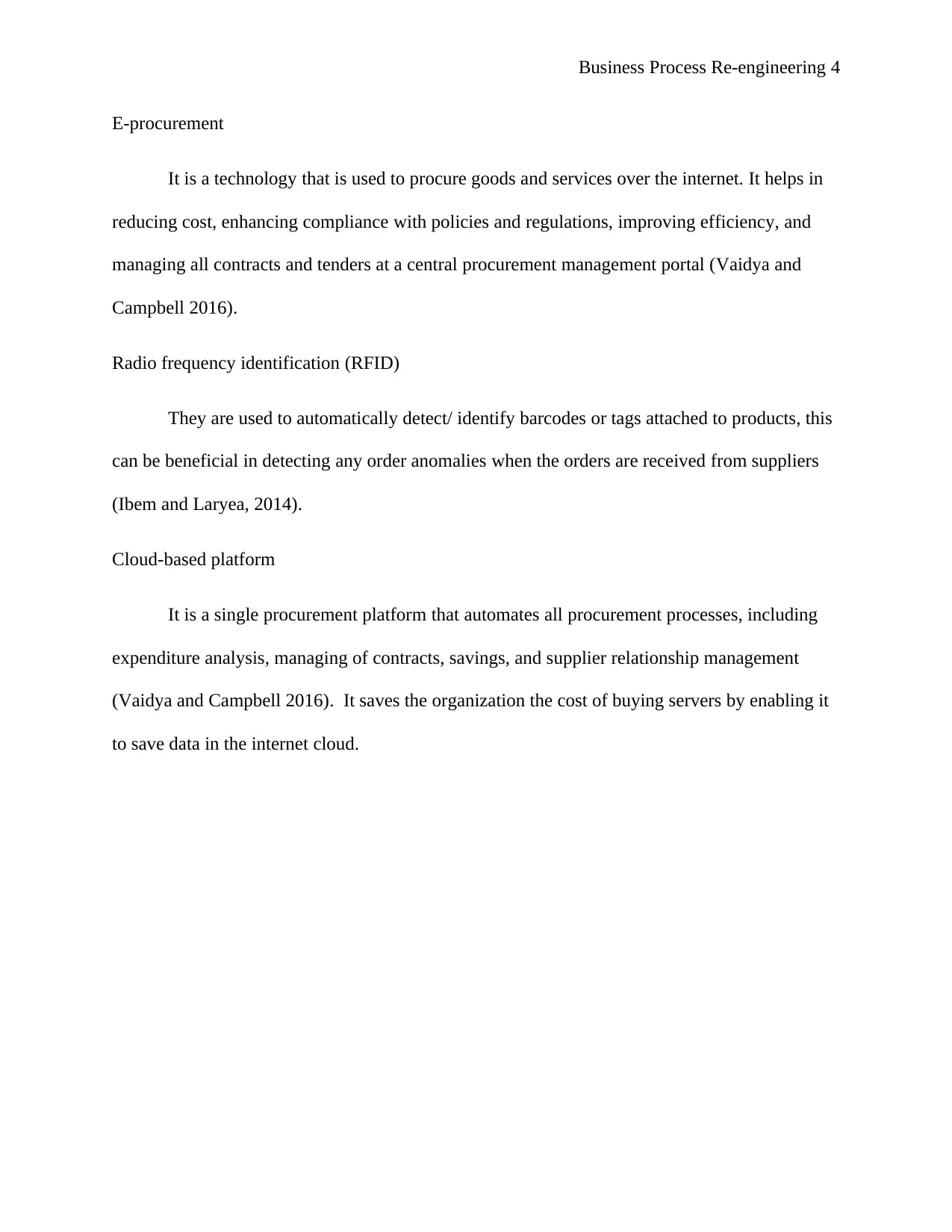
Business Process Re-engineering 4
E-procurement
It is a technology that is used to procure goods and services over the internet. It helps in
reducing cost, enhancing compliance with policies and regulations, improving efficiency, and
managing all contracts and tenders at a central procurement management portal (Vaidya and
Campbell 2016).
Radio frequency identification (RFID)
They are used to automatically detect/ identify barcodes or tags attached to products, this
can be beneficial in detecting any order anomalies when the orders are received from suppliers
(Ibem and Laryea, 2014).
Cloud-based platform
It is a single procurement platform that automates all procurement processes, including
expenditure analysis, managing of contracts, savings, and supplier relationship management
(Vaidya and Campbell 2016). It saves the organization the cost of buying servers by enabling it
to save data in the internet cloud.
E-procurement
It is a technology that is used to procure goods and services over the internet. It helps in
reducing cost, enhancing compliance with policies and regulations, improving efficiency, and
managing all contracts and tenders at a central procurement management portal (Vaidya and
Campbell 2016).
Radio frequency identification (RFID)
They are used to automatically detect/ identify barcodes or tags attached to products, this
can be beneficial in detecting any order anomalies when the orders are received from suppliers
(Ibem and Laryea, 2014).
Cloud-based platform
It is a single procurement platform that automates all procurement processes, including
expenditure analysis, managing of contracts, savings, and supplier relationship management
(Vaidya and Campbell 2016). It saves the organization the cost of buying servers by enabling it
to save data in the internet cloud.
Paraphrase This Document
Need a fresh take? Get an instant paraphrase of this document with our AI Paraphraser
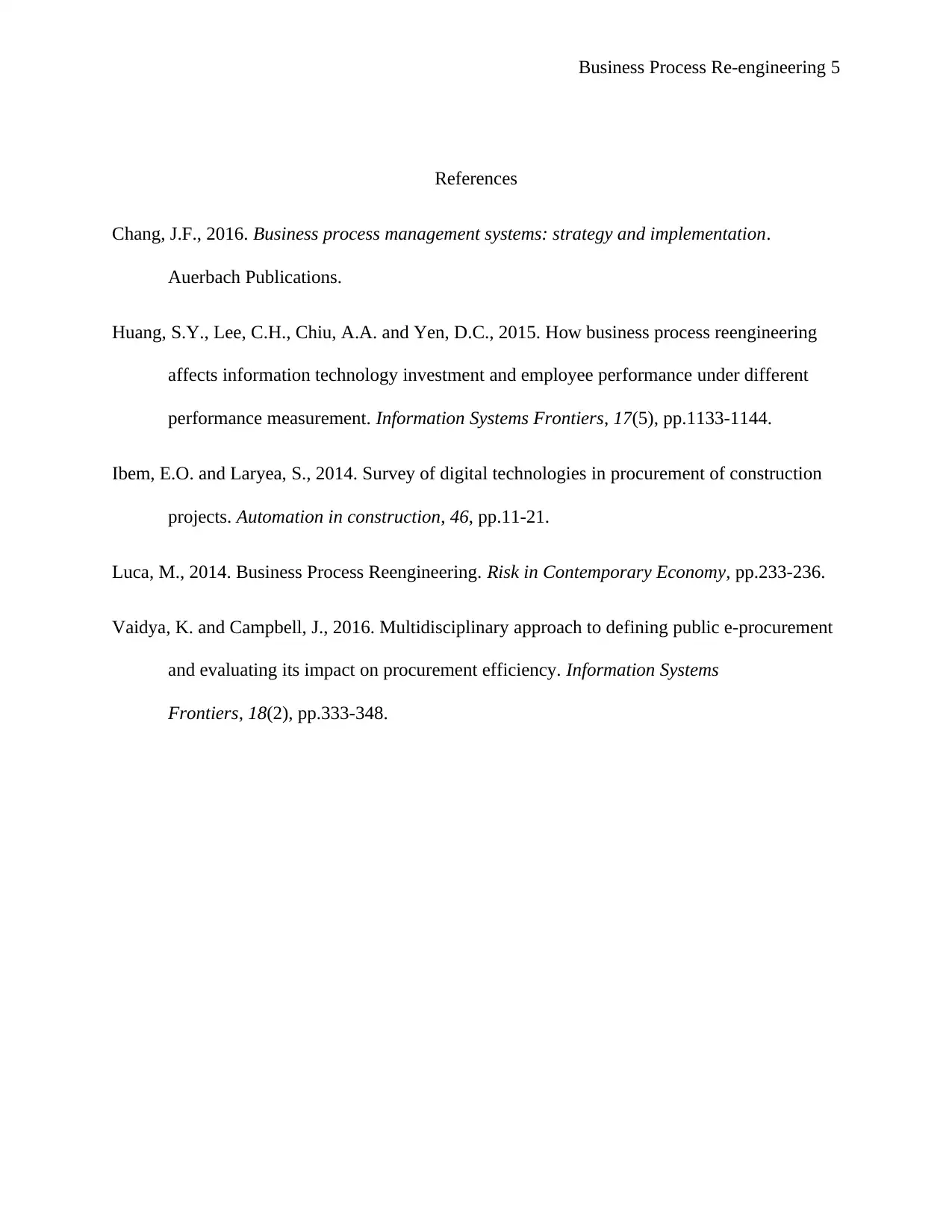
Business Process Re-engineering 5
References
Chang, J.F., 2016. Business process management systems: strategy and implementation.
Auerbach Publications.
Huang, S.Y., Lee, C.H., Chiu, A.A. and Yen, D.C., 2015. How business process reengineering
affects information technology investment and employee performance under different
performance measurement. Information Systems Frontiers, 17(5), pp.1133-1144.
Ibem, E.O. and Laryea, S., 2014. Survey of digital technologies in procurement of construction
projects. Automation in construction, 46, pp.11-21.
Luca, M., 2014. Business Process Reengineering. Risk in Contemporary Economy, pp.233-236.
Vaidya, K. and Campbell, J., 2016. Multidisciplinary approach to defining public e-procurement
and evaluating its impact on procurement efficiency. Information Systems
Frontiers, 18(2), pp.333-348.
References
Chang, J.F., 2016. Business process management systems: strategy and implementation.
Auerbach Publications.
Huang, S.Y., Lee, C.H., Chiu, A.A. and Yen, D.C., 2015. How business process reengineering
affects information technology investment and employee performance under different
performance measurement. Information Systems Frontiers, 17(5), pp.1133-1144.
Ibem, E.O. and Laryea, S., 2014. Survey of digital technologies in procurement of construction
projects. Automation in construction, 46, pp.11-21.
Luca, M., 2014. Business Process Reengineering. Risk in Contemporary Economy, pp.233-236.
Vaidya, K. and Campbell, J., 2016. Multidisciplinary approach to defining public e-procurement
and evaluating its impact on procurement efficiency. Information Systems
Frontiers, 18(2), pp.333-348.
1 out of 5
Related Documents
Your All-in-One AI-Powered Toolkit for Academic Success.
+13062052269
info@desklib.com
Available 24*7 on WhatsApp / Email
![[object Object]](/_next/static/media/star-bottom.7253800d.svg)
Unlock your academic potential
Copyright © 2020–2025 A2Z Services. All Rights Reserved. Developed and managed by ZUCOL.





